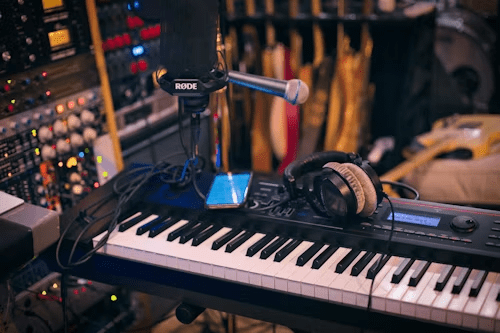In the distinctive realm of music creation, a keyboard controller fills in as the heartbeat of a musician’s innovative process. Whether you’re an old pro or a yearning craftsman, the choice of a keyboard controller can fundamentally shape the manner in which you connect with your computerized instruments and software.
Join us in unwinding the key components that change a keyboard controller from a simple device into an indispensable muse for your creative endeavors.
In this article, we’ll investigate the fundamental perspectives that characterize an excellent keyboard controller. Understanding these seven fundamental elements is significant in making an informed choice that lines up with your musical style, preferences, and creation workflow.
1. Key Action and Sensitivity
Integral to the domain of the keyboard controller is a vital part of key action and sensitivity. These properties characterize the tactile experience of playing, influencing how the keys respond to a performer’s touch.
Key activity refers to the instrument deciding the resistance and feel of the keys, with options going from weighted for a piano-like feel to synth action for a lighter touch. On the other hand, sensitivity directs how well the controller translates shifting playing dynamics.
A quality keyboard with adaptable speed curves guarantees a comfortable and expressive playing experience, permitting performers to convey the complexities of their performance with artfulness and accuracy.
2. Number and Type of Keys
The number and sort of keys are fundamental contemplations based on the kind of music you produce. This aspect is closely attached to the variety of melodic genres and preferences. For those focused on a more extensive range of music, standard 49 or 61-key controllers could do the work.
Nonetheless, those diving into piano or symphonic works might find an 88-key controller more reasonable. Besides, the incorporation of aftertouch functionality adds one more layer of expressiveness, permitting performers to infuse subtleties into their compositions.
This happens when parameters are changed progressively based on the pressure applied after a key is first struck. The flexibility in the number and kind of keys opens ways to imaginative exploration and custom-made melodic expressions.
3. MIDI Connectivity
MIDI connection is crucial for a keyboard controller’s operation. The correspondence interface between the controller and other computerized gadgets or programming is laid out through this capability.
Look for a controller with a trustworthy MIDI interface that has both customary MIDI and USB connectors. As a result of its flexibility, it works flawlessly with different gadgets, including outer equipment synthesizers and PCs.
Strong MIDI connections empower entertainers to integrate their keyboard controller into different setups, expanding the potential for creative partnerships between different instruments and innovation. An exceptional MIDI connection is fundamental for making a consistent and connected musical experience, whether you’re making complex symphonies or electro rhythms.
4. Assignable Controls
The best keyboard controllers come equipped with various assignable controls, like knobs, sliders, and buttons. These controls act as the courses through which artists exert real-time influence over their advanced instruments and software.
A controller with an adequate exhibit of programmable controls empowers users to control different parameters, encouraging a hands-on and intuitive way to deal with music creation progressively. The distinction between mechanized and touch-sensitive controls improves responsiveness, offering an elevated degree of communication.
The capacity to customize mappings guarantees the controller adjusts consistently with individual work processes, opening new dimensions of creativity as clients shape their sonic landscapes with accuracy and finesse.
5. Compatibility and Integration
Compatibility and integration structure the foundation of a viable keyboard controller, directly influencing its convenience in a music creation landscape.
It is essential to pick a controller that consistently lines up with your favored digital audio workstation (DAW) and other programming instruments. Numerous controllers are enhanced for specific DAWs, giving pre-arranged mappings and profound integration that smoothes out the inventive strategy.
Devoted transport controls further improve the user experience, taking into account effortless navigation and recording. The harmonious incorporation of controller and software makes a symbiotic relationship, catalyzing a fluid and natural music-creation work process.
6. Build Quality and Portability
The frequently disregarded, yet essentially pivotal, part of a keyboard controller is its build quality and portability. A strong and well-constructed controller isn’t just a demonstration of longevity but additionally guarantees dependability during elongated use.
Great materials and robust construction add to the overall security of the controller, providing a strong foundation for innovative exploration. For those on the move or with restricted studio space, the controller’s portability turns into a definitive variable. Conservative plans and lightweight forms work with the simplicity of transport, making it an optimal ally for performers in a hurry.
Moreover, elements, for example, illuminated buttons and a clear showcase upgrade client collaboration, guaranteeing a consistent and pleasant musical journey even in low-light circumstances. The tactile experience of the controller stretches out past the keys, including each feature of its physical design for a vivid and enduring innovative partnership.
7. Additional Features and Software Bundles
Numerous keyboard controllers come packaged with software instruments, test libraries, or advanced sound workstations. Assess the included software and decide its importance to your music creation needs.
A few controllers likewise offer unique elements, for example, arpeggiators, harmony modes, or drum cushions, improving your innovative possibilities. Consider these extra elements and software packs while deciding.
Bottom Line
Picking the right keyboard controller is an essential step toward enhancing your music creation setup. By focusing on the key features mentioned above, you can guarantee that your controller lines up with your melodic preferences and workflow.
Take time to research and test various choices to track down the keyboard controller that supplements your style and upgrades your imaginative articulation in the realm of music creation.

As the editor of the blog, She curate insightful content that sparks curiosity and fosters learning. With a passion for storytelling and a keen eye for detail, she strive to bring diverse perspectives and engaging narratives to readers, ensuring every piece informs, inspires, and enriches.










